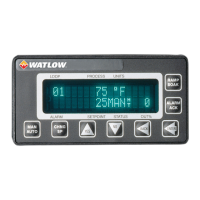CLS200 Series User’s Guide
Chapter 8: Troubleshooting and Reconfiguring
154
EIA/TIA-485. Follow these steps:
1. Power down the unit.
2. Remove the controller’s metal casing. See Replacing the EPROM on page 150 for step-by-
step instructions.
3. On the top board find the four-jumper block on JU2, JU3, JU4 and JU5.
4. Use tweezers to carefully slide the jumper block off the pins.
5. Use tweezers to gently slide the four-jumper block onto the correct pins (see Figure 8.8).
6. If you are configuring the controller as the last device on an EIA/TIA-485 network, move JU1 to
the B position.
7. Reassemble the controller.
Scaling Resistors
Resistors are installed for all inputs on the CLS200. Inputs with signal ranges between -10 and
+60mV use 0Ω resistors in the RC position only. All other input signals require special input scaling
resistors.
The following sections describe the scaling resistors to help you determine how a unit is configured.
NOTE! Scaling resistors cannot be changed in the field. For input types other than
thermocouples, the controller must be ordered with and factory configured with scaling
resistors.
Four-Loop and Eight-Loop Input Circuit
Four-loop and eight-loop controllers can accept differential thermocouple, mV DC, VDC, mADC
and RTD inputs. Unless ordered with special inputs these controller accept only signals within
the standard range -10 to 60mVDC. To accommodate other signals, the input circuit must be
modified. When configured for thermocouple inputs, 0Ω resistors are installed in all RC locations.
To accommodate voltage signals outside the standard range, milliamp current signals or RTDs,
resistors are added or replaced to scale the signals to the standard range.
Com
IN-
RC (RTD)
IN+
RD
RP
Analog
Input
Terminal
Internal
RP
+5VÎ (dc)
Reference
To CLS200
Circuitry
RC (Voltage)
+
-
Figure 8.9 — Differential Input Circuit in Four-Loop and Eight-Loop Controllers

